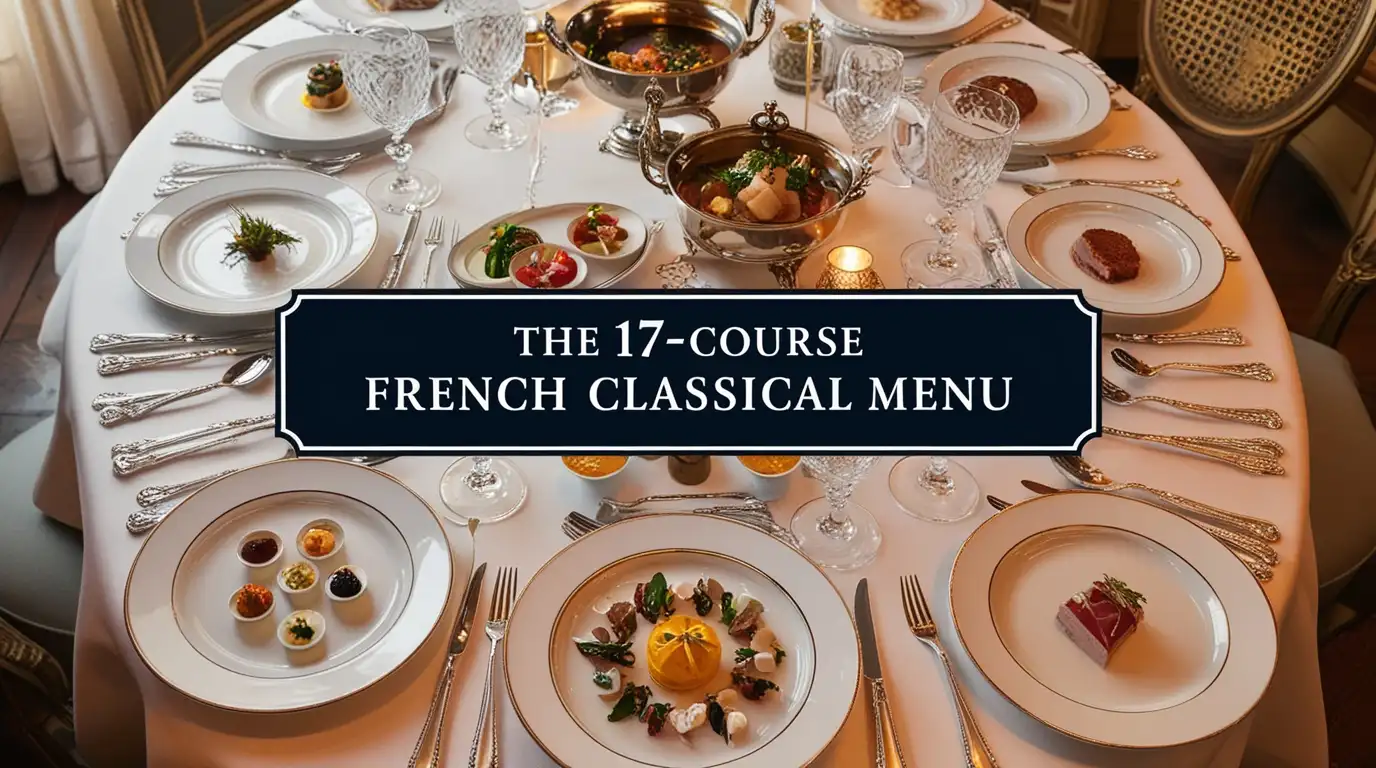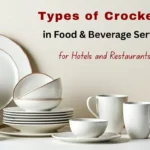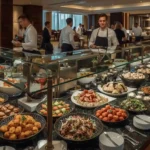French cuisine is renowned worldwide for its sophistication and elegance. A quintessential aspect of this culinary tradition is the 17-course French Classical Menu, a formal dining sequence that showcases a wide variety of dishes served in a specific order. This menu structure, rooted in fine dining, reflects the harmony of flavours, balance, and attention to detail in French gastronomy.
This guide explores each of the 17 courses, providing descriptions, examples, and the covers used for serving. Whether you’re a student, hospitality professional, or culinary enthusiast,
What is a French Classical Menu?
A French classical menu is a structured dining sequence consisting of 17 courses that follow a specific order. Each course has its unique purpose, progressing from light appetizers to rich, flavorful mains and concluding with desserts.
This tradition originated in the French aristocracy during the 19th century and remains an essential part of classical European fine dining.
Want to learn more about the menu? read our guide on: A la carte menu, meaning, characteristics, advantage and disadvantage
A Quick Overview of the 17-Course French Classical Menu
- Hors-d-oeuvre (Appetizer)
- Potage (Soup)
- Oeufs (Egg)
- Farinaceous / Farineaux (Pasta or Rice)
- Poisson (Fish)
- Entree (First meat course)
- Releve (Main meat course or joints of meat)
- Sorbet (Rest course)
- Roti (Roast)
- Legumes (Vegetables)
- Salades (Salad)
- Buffet Froid (Cold Buffet)
- Entremets (sweets)
- Savourex (savory)
- Fromage (Cheese)
- Dessert (Fruits)
- Cafe(coffee)
Here’s a detailed infographic summarizing the 17-course French classical menu for a quick overview before diving into each course’s explanation.
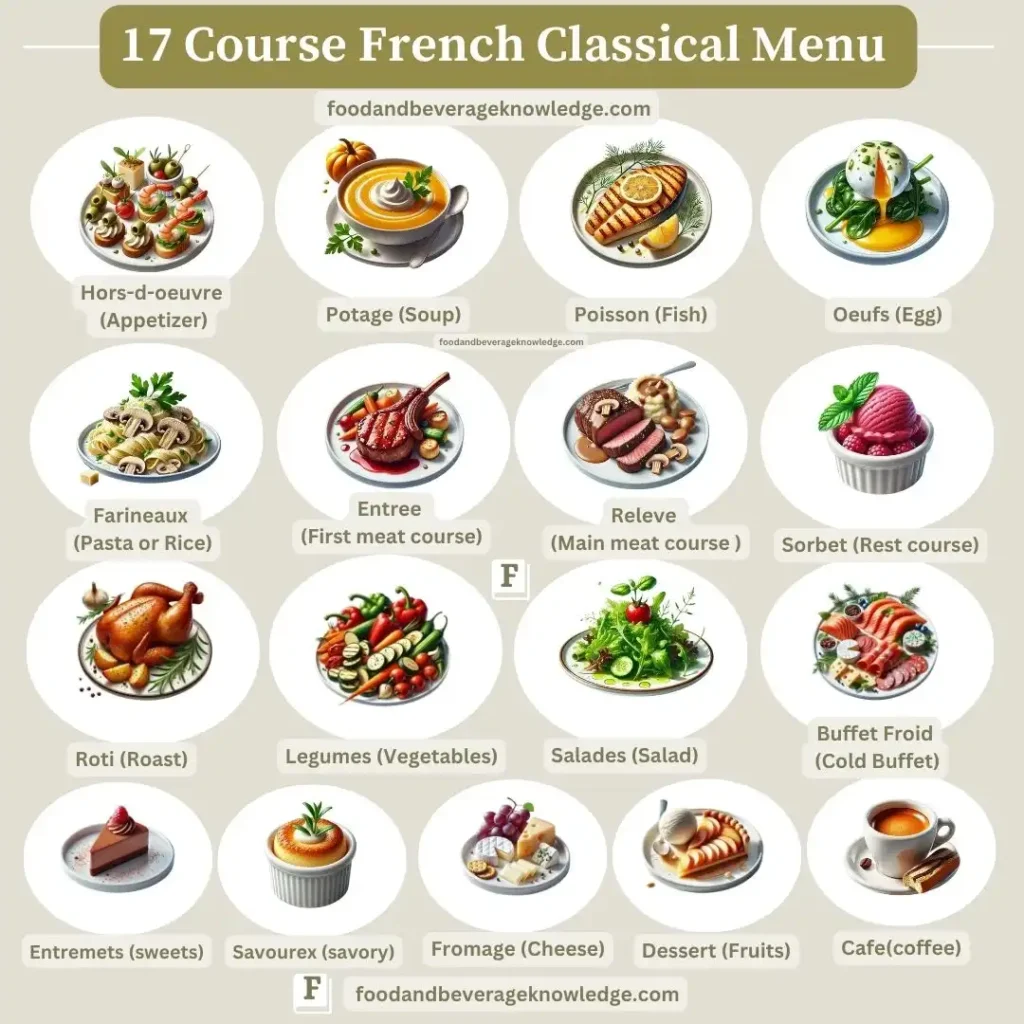
The 17 Courses of the French Classical Menu
Below is the detailed sequence of the 17 courses with descriptions, examples, and appropriate covers:
1. Hors-d-oeuvre (Appetizer)
Pronunciation: “or-DURV”
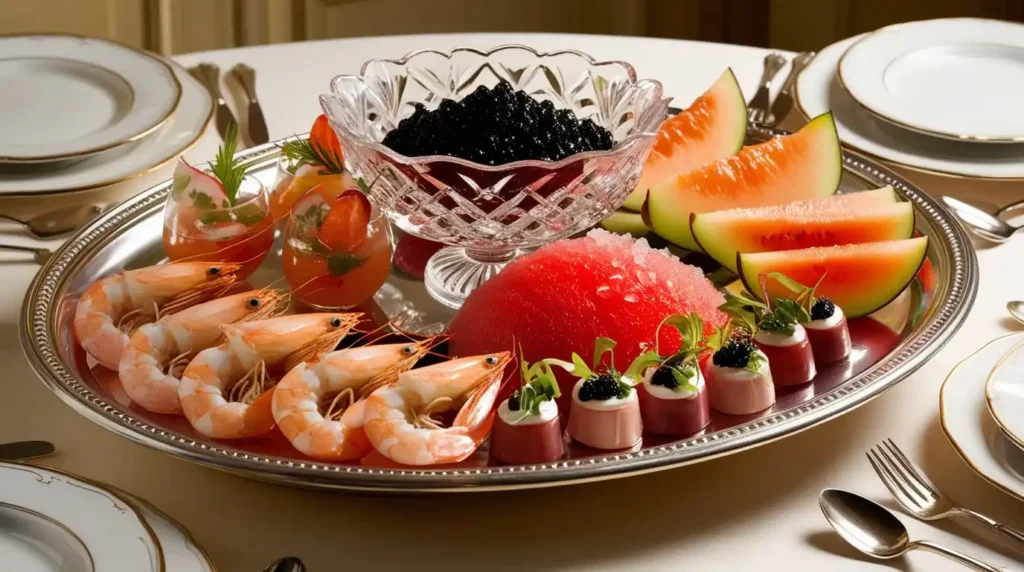
Hors d’oeuvre is the first course in a French classical menu, designed to stimulate the appetite. Delicate, tangy, and often salty dishes are served in small portions. It is usually served from a rotating trolley or a tray a small amount of each variety is placed on the plate to make up a portion.
They include both general hors d’oeuvre (like salads, cold meats, or fish) and classical hors d’oeuvre (like fruit juice, melon, oysters, or caviar). These light bites are presented elegantly on small plates or cocktail glasses and create anticipation for heavier courses.
There are generally two types from the service point of view.
1. General Hors d’oeuvre: Includes all cold preparations, typically served as light appetizers to stimulate the appetite.
Some examples of General Hors d’oeuvre are:
- Russian Salad: A creamy salad made with diced vegetables, mayonnaise, and sometimes ham or chicken.
- Fish Mayonnaise: Poached fish served cold with a mayonnaise dressing, garnished with vegetables or eggs.
- Chicken Galantine: A deboned, stuffed chicken roll served cold, often with jelly and decorative garnishes.
- Pâté de Foie Gras: A rich, smooth paste made from goose liver, served with bread or crackers.
2. Classical Hors d’oeuvre: Refined, traditional dishes served with specific covers and presentations
Some examples of Classical Hors d’oeuvre are:
- Fruit Juice/Soft Drinks: Juices like tomato, apple, or grapefruit.
- Grapefruit: Served in a grapefruit cup or half plate with a grapefruit spoon.
- Melon: Cantaloupe, honeydew, or watermelon on crushed ice.
- Shellfish Cocktail: Shrimp or crab in cocktail sauce, garnished with parsley and egg.
- Oyster: Served raw on crushed ice, portioned as six or twelve.
- Caviar: Sturgeon roe served by weight in its container.
- Common Types: Beluga, Sevruga, Oscietre.
Also Read: Table d’hôte menu, meaning, characteristics, advantage and disadvantage
2. Potage (Soup)
Pronunciation: “or-DURV”
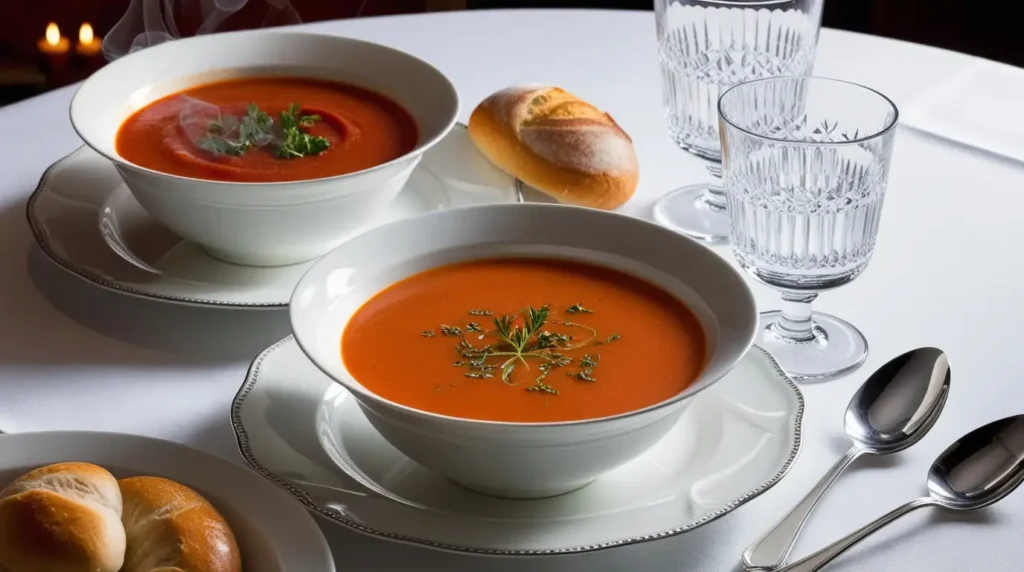
Potage is the soup course that provides warmth and comfort, preparing diners for the flavors of subsequent courses. Soups in the French classical menu can be clear or thick, such as consommé or velouté, and are often served with complementary accompaniments like croutons or bread rolls.
This course is integral to balancing the meal, offering both nourishment and a subtle introduction to the chef’s skill.
In the absence of an appetizer on the menu, soup assumes the role of an appetizer. It stimulates the appetite for heavier food
Soup is served in a soup bowl or soup plate on an underplate over a doily paper. soup is placed on the cover.
There are basically two types of soup thick soup and thin soup on the menu.
1. Thick Soups:
Thick soups are rich and hearty, made by blending ingredients to achieve a dense consistency. Types include purées, creams, veloutés, bisques, and chowders, offering bold flavors and textures. Examples include Cream of Tomato and Crab Bisque.
2. Thin Soups:
Thin soups are light and clear, highlighting delicate flavors with a broth-like consistency. These include consommés, which are clarified for transparency, and simple broths. Examples include Chicken Broth and Consommé Julienne.
Examples of Potages are:
- Consommé julienne: Clear soup garnished with strips of root vegetables
- Consommé Celestine: Clear soup garnished with strips of savory pancakes.
- Consommé royal: Clear soup consists of shredded vegetables and minced mutton.
- Bisque d’homard: Thick lobster-flavoured soup
- Creme de tomato: Cream of tomato soup.
- Minestrone soup: A thick Italian vegetable soup
- Petite marmite: Clear soup,made from a variety of meats and vegetables
- Vichyssoise: A thick cold soup made of puréed leeks, onions, potatoes, cream, and chicken stock
Cover: Soup bowl or soup plate, underplate, soup spoon.
3. Oeufs (Egg)
Pronunciation: “UFF”
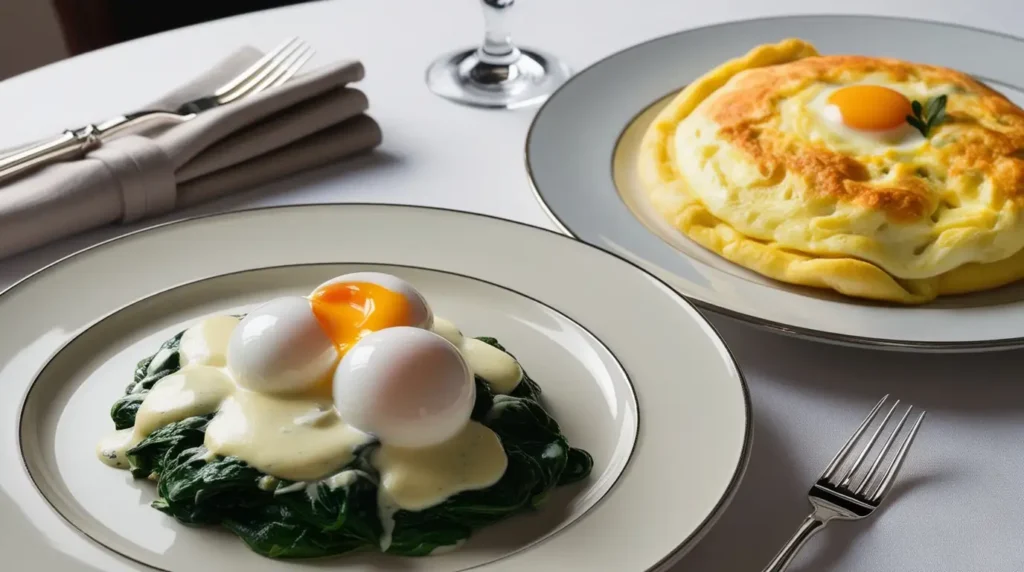
The third course highlights the versatility of eggs, offering a variety of light yet satisfying dishes. Eggs are prepared in different styles—poached, scrambled, or baked. Classic examples include Omelette, Eggs Benedict, and Scrambled Eggs with Smoked Salmon.
These dishes are typically paired with delicate accompaniments like hollandaise sauce or herbs. Presented warm and on individual plates, this course showcases the chef’s creativity in crafting unique egg-based dishes.
The egg may be given in place of the fish course after appetizer and soup courses. They are not included in set dinner menus as this makes one feel quite heavy during dinner
Examples of oeufs are:
- Oeuf Poche florentine: poached egg on a bed of spinach coated with cheese sauce & gratinated
- En cocotte: A French way of baking eggs in a water bath in the oven
- Omelette chasseur: omelet with chicken livers and mushrooms.
- Egg Chimay: Boiled egg with mushroom sauce and cheese.
- Omelette Espagnole: flat omelet with onions, pepper, tomato
- Oeufs en cocotte a la creme: egg cooked in its own dish in a bain-marie and garnished with cram.
- Oeufs sure le plant: An elegant egg dish
Cover: Egg plate or bowl, egg spoon, egg cup, napkin.
4. Farinaceous / Farineaux (Pasta or Rice)
Pronunciation: “fa-ree-NAY-shus” / “fa-ree-NOH”

Farineaux highlights starch-based dishes like pasta, rice, or grains, showcasing culinary artistry and balance. This course enriches the menu by providing texture and substance, serving as a transition from the lighter courses to the more robust flavours of meat and seafood.
Often regarded as Italy’s culinary contribution to the French classical menu, Farineaux celebrates the versatility of rice and pasta, crafted from unleavened wheat flour dough combined with water or eggs.
Examples of Farinaceous / Farineaux are:
- Spaghetti bolognaise: Spaghetti blended with minced lean beef with rich brown sauce.
- Spaghetti napolitine: Spaghetti in a tomato- and garlic-flavored sauce.
- Spaghetti alla carbonara: Spaghetti pasta, with raw eggs, Pecorino Romano cheese, and bacon.
- Ravioli di borragine: Ravioli dumplings, filled with ricotta cheese and Borage, served with butter and walnuts
- Gnocchi alla romana: Soft dough gnocchi dumplings, made with, eggs, milk, and Parmigiano-Reggiano cheese and baked with butter and pecorino Romano cheese
- Lasagne alla napoletana: A Neapolitan dish of baked lasagne flat-shaped pasta, made with several layers of lasagne sheets alternated with ragù sauce, mozzarella cheese
- Cannelloni ricotta e spinaci: A baked pasta dish, made with cannelloni, filled with a sauce of ricotta cheese and spinach.
Cover: Pasta plate or bowl, pasta fork, spoon, napkin.
5. Poisson (Fish)
Pronunciation: “pwah-SOHN”

The fifth course, Poisson, introduces seafood prepared with finesse, emphasizing fresh, delicate flavours. This course often showcases regional specialities, such as trout, salmon, or sole, paired with complementary sauces.
Poisson serves as a lighter alternative to meat and is strategically placed before the heavier entrees to maintain balance in the dining experience.
There are basically two types of fish preparations
1. Poached Fish Preparation:
Poached fish is gently cooked in liquid to preserve its delicate texture and flavour. It is typically served with rich sauces like Hollandaise, Mousseline, or Mayonnaise, either on top or on the side. Examples include Fillet of Pomfret Veronique and Fillet of Sole Mornay.
2. Fried, Grilled, or Baked Fish:
These methods create a dry texture, often with a crispy exterior, and are served with a complementary sauce. Fried, grilled, and baked fish offer a variety of flavours and textures, such as in dishes like Fillet of Pomfret Orly and Grilled Herring.
Examples of poission are:
- Sole meuniere: Sole shallow fried in butter.
- Sole colbert: Sole, flour, egg, and breadcrumbed and deep-fried, the fillet is rolled back of backbone in preparation.
- Sole cubat: Filled with sole poached, dressed on a mushroom puree and coated with cheese sauce.
- Fillet de pie frite: Fillet of plaice deep-fried and accompanied by a mayonnaise-based sauce flavored with capers, gherkins, and parsley.
- Trocon de turbot poche: Cutlet of turbot poached with an egg and butter-based sauce.Blanchailles diables: whitebait well seasoned with cayenne pepper and deep-fried.
Cover: Half plate, fish knife, fish fork.
6. Entree (First meat course)
Pronunciation: “ahn-TRAY”

The sixth course, Entrée, features a light meat dish, often poultry or game. The word “entrée,” derived from the French word for “entry,” signifies the shift toward heartier fare in the meal. Typically accompanied by a light sauce and seasonal vegetables, the entrée showcases the chef’s skill in flavor pairing.
This course serves as a bridge, preparing diners for the more substantial roasts and grilled meats to come. Entrées are generally small, well-garnished dishes, often accompanied by a rich gravy or sauce.
The entrée is the first meat course in the French classical menu and may sometimes be served as the main course.
Examples of Entrees are:
- Poulet saute chasseur: saute chicken in a rich brown sauce flavoured with tomato and mushroom.
- Supreme de volaille a la king: Breast and wing of chicken cooked under a cover in the oven.
- Emincee de volaille a la king: Minced chicken with savoury rice.
- Foie de veau au lard: Liver with bacon.
- Steak Diane: Minute steak shallow fried and flavoured with onion and mushroom sauce finished with red wine and cream.
- Rognons saute turbigo: kidneys shallow fried and blended with rich brown sauce garnished with chipolata sausages.
Cover: Half plate, small knife, and fork.
7. Releve (Main meat course or joints of meat)
Pronunciation: “ruh-luh-VAY”
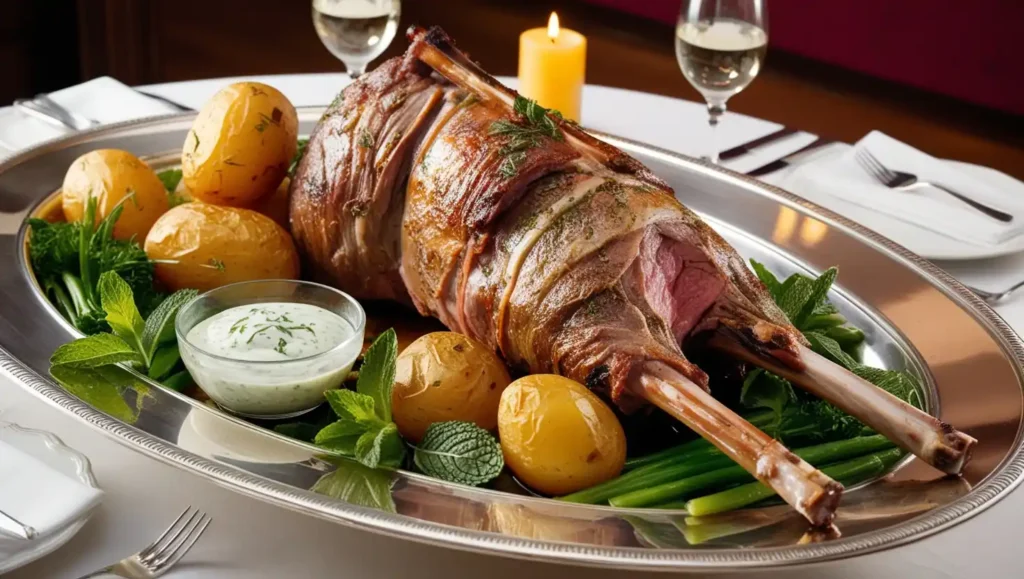
The seventh course, Relevé, is the main course of the French classical menu and features large cuts of meat, such as lamb, beef, veal, or pork. These cuts are typically roasted, braised, or boiled and carved tableside. The course is accompanied by rich sauces, roast gravy, potatoes, and green vegetables.
Relevé is the heaviest course, providing substantial portions and bold flavours. Typical dishes include saddle of mutton, baron of beef, boned sirloin, and braised ham. This course highlights the skill of the chef in preparing and presenting large meat joints.
It is served on a large platter, emphasizing its importance as the centerpiece of the meal. Positioned after the lighter entrée, Relevé adds depth and heartiness to the dining experience.
Examples of Releves are:
- Contrefilet de boeuf roti a l anglaise: boned and roasted sirloin of beef.
- Carre d agneau roti: roast best end of lamb
- Cuissot de porc roti puree de pommes: roast leg of pork with apple sauce.
- Gigot d agneau roti sauce menthe: roast leg of lamb with mint sauce
- Tom Kerridge’s braised ham hocks in Cumberland spices
- Mustard and Thyme Baron of Beef Au Jus
- Herby stuffed saddle of lamb with crushed roasties
Cover: Large plate, large knife, large fork
8. Sorbet (Rest course)
Pronunciation: “sor-BAY”

sorbets are water ice flavoured with champagne or wine or liqueur and essences and are served in a tall glass with a teaspoon/sundae spoon. It is the best course on the French classical menu.
It is intended to give rest during a long meal and to stimulate the appetite for the rest course, During this course, Russian cigars and cigarettes are passed around.
Examples of sorbets are:
- Champagne Sorbet: Light, icy sorbet infused with champagne.
- Lemon Sorbet: Tangy, refreshing lemon-flavored ice.
- Pineapple Sorbet: Sweet sorbet made with pineapple juice.
- Raspberry Sorbet: Vibrant sorbet made with fresh raspberries.
- Strawberry Sorbet: Sweet and fruity strawberry-flavored ice.
- Mint Sorbet: Light sorbet with a refreshing mint flavour.
Cover: Water tumbler or tall glass, and underplate with a teaspoon. Cigar cutter and matchbox.
9. Roti (Roast)
Pronunciation: “roh-TEE”
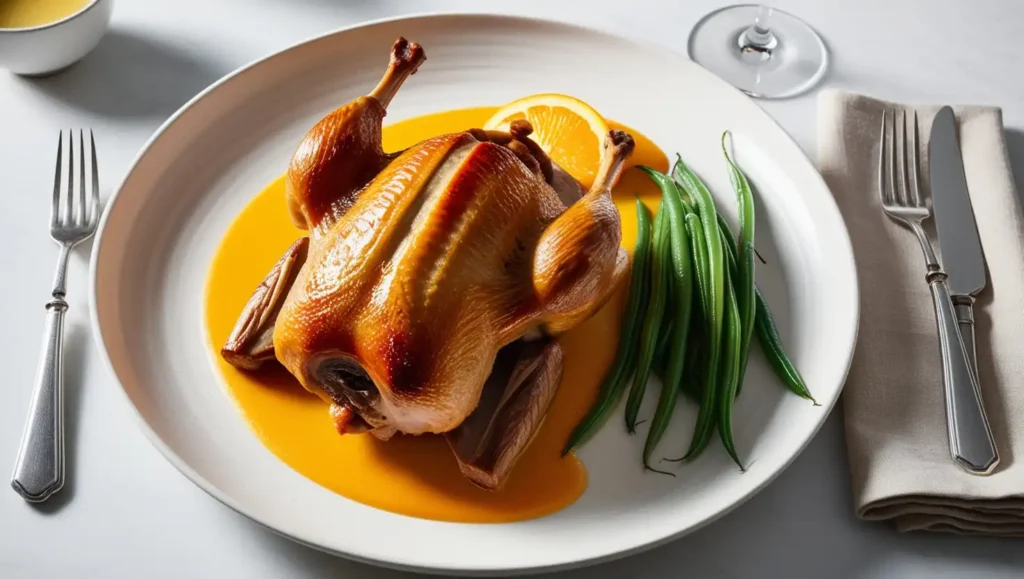
In this course, roasted poultry and game birds are included. If poultry or game birds are cooked by any other cooking method, then those dishes will not be considered as a roast course.
Salad is served separately on a half-moon plate with this course. Orange salad is offered with roast duck. This second heaviest course of the 17 courses on the French classical menu.
It is served on a large plate from a platter by service gear or served as a Pre-plated dish with proper accompaniment and garnish. A large fork and large knife are arranged on the cover.
Examples of Roti are:
- Poulet Rôti: Roasted chicken served with gravy.
- Canton Rôti: Roasted duck served with apple sauce.
- Roast Pheasant: Game bird roasted and garnished with seasonal vegetables.
- Roast Quail: Small game bird roasted with herbs.
- Roast Goose: Rich, roasted goose served with orange sauce.
- Roast Partridge: Game bird roasted and served with bread sauce.
Cover: Large plate, large knife, large fork.
Related post: What is Menu Planning? Definition, Importance, and Best Practices
10. Legumes (Vegetables)
Pronunciation: “lay-GOOM”
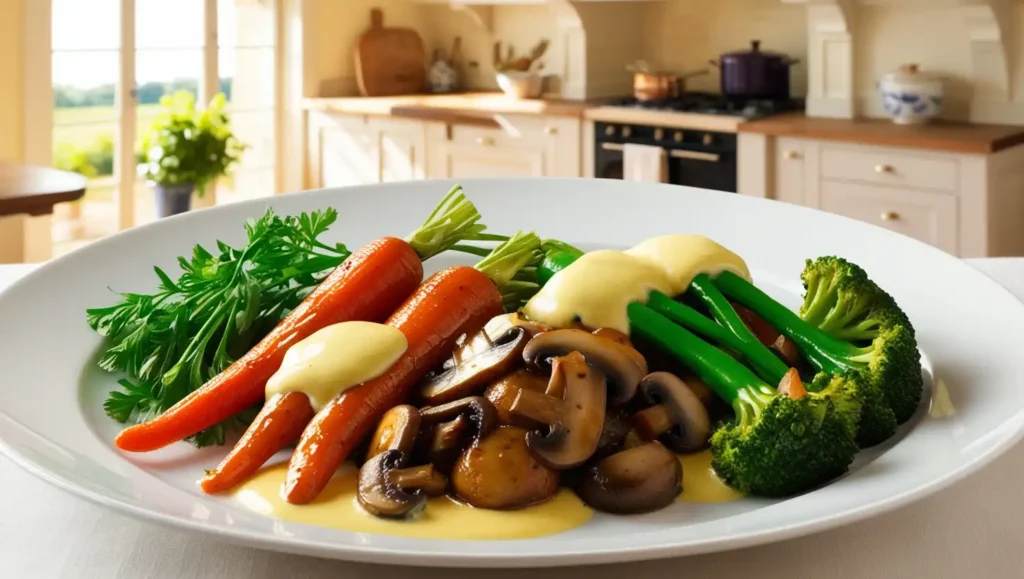
All vegetable preparation comes under this course. Vegetables may be served as the main course on a shorter menu. Different types of vegetables such as mushrooms, artichokes, carrots, broccoli, and asparagus are served in this course.
These are vegetable dishes that can be served separately as an individual course with its own sauce like hollandaise sauce or beurre fondue, or can be served along with the entrée, relevé, or roast courses.
Some Examples of Legumes are:
- Puree de pommes: Creamed potatoes.
- Pommes au four: Baked jacket potato.
- Petits pois au beurre: peas tossed in butter.
- Epinards en branches: Leaf spinach.
- Champignons grille: Grilles mushroom.
- Choufleur morney: Cauliflower with cheese sauce.
- Celeries braises: Braised celery
Cover: Half plate, small knife, small fork
11. Salades (Salad)
Pronunciation: “sah-LAHD”
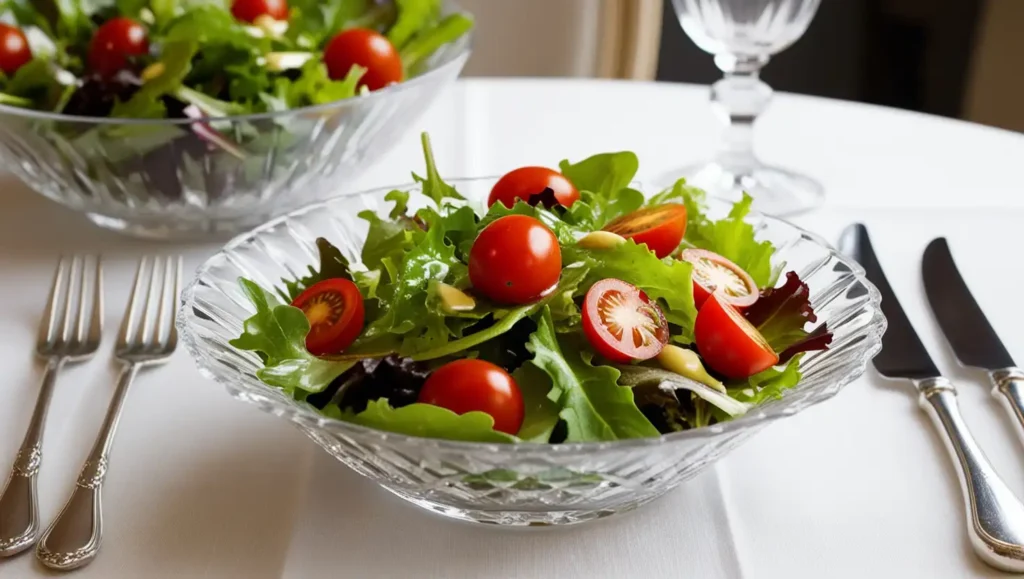
Traditionally served after the main meat courses, salade offers a crisp, refreshing break to cleanse the palate. This course features lightly dressed greens or a mix of vegetables, providing a contrast to the richness of the preceding dishes.
The eleventh course helps rejuvenate the diner’s appetite, preparing them for the upcoming savory courses. It can include various types of salads, such as simple salads or compound salads, and may consist of cold dishes or green vegetables.
Some examples of salades are:
- Waldorf Salad: Apples, walnuts, and celery in mayonnaise.
- Greek Salad: Fresh cucumbers, tomatoes, olives, and feta cheese.
- Tossed Salad: Mixed greens with light vinaigrette.
- Coleslaw: Shredded cabbage and carrots with creamy dressing.
- Andalouse Salad: Tomato and pepper salad with an oil-based dressing.
- Caesar Salad: Romaine lettuce with Parmesan, croutons, and Caesar dressing.
Cover: Salad plate, salad fork, salad knife, napkin.
12. Buffet Froid (Cold Buffet)
Pronunciation: “boo-FAY frwah”

The twoeventh course, buffet froid, features a variety of cold meats, fish, and salads, often accompanied by dressings. Dishes such as galantines, aspics, and cold cuts are served, offering a sophisticated contrast to the warm courses.
This course highlights the versatility of French cuisine, emphasizing both flavour and visual presentation. Buffet froid provides a light yet satisfying addition to the meal, showcasing the artistry of cold dishes.
Examples of buffet Froid:
- Chicken Galantine: Cold stuffed chicken dish.
- Poached Salmon: Cold salmon served with herby mayonnaise.
- Lobster Mayonnaise: Lobster garnished with greens and served with sauce.
- Smoked Salmon: Thin slices of cold smoked salmon.
- Herb-Stuffed Pork Loin: Cold pork loin stuffed with herbs.
- Duck Terrine: Rich duck pâté served chilled.
- Roast Beef Salad: Thin cold beef slices with a light dressing.
Cover: Buffet plate, cold meat knife, small fork, napkin.
13. Entremets (sweets)
Pronunciation: “ahn-truh-MAY”
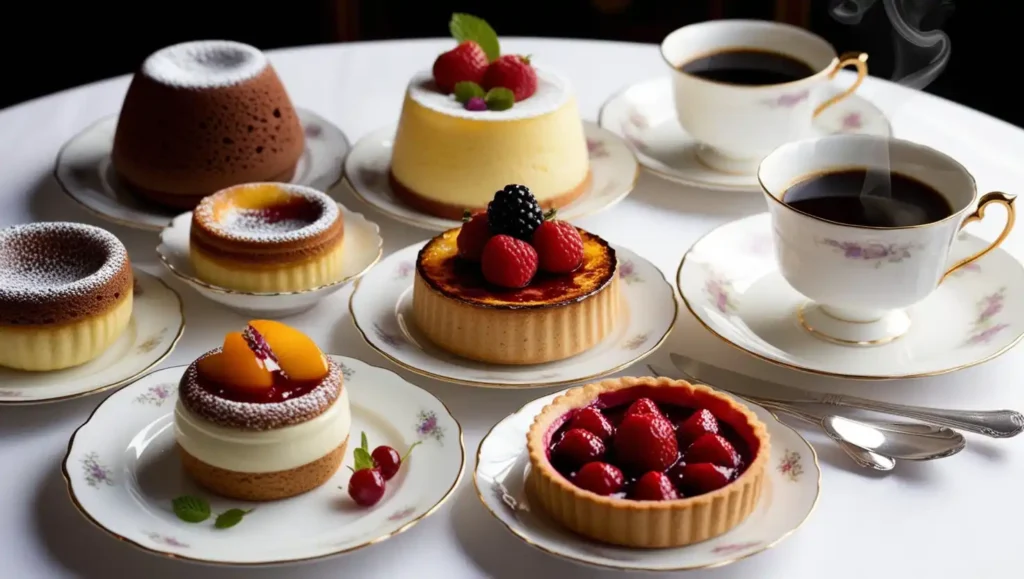
The term Entremets means the entry of the sweet item. All kinds of sweet preparations, such as shuffles, custards, pudding, fool, bavarois, crepes, ice cream, and pastries, whether cold or hot are included in this course.
Entremets are generally two types General Entremets and Ice cream
1. General Entremets
Different types of pudding, cake, and pastry, are served, it may be hot or cold. It is served either pre-plated or platter to plate with the help of a service spoon and service fork.
Examples of General Entremets:
- Crème Caramel: Soft caramel custard dessert.
- Apple Strudel: Pastry filled with spiced apples and raisins.
- Chocolate Soufflé: Light, fluffy chocolate dessert.
- Baked Alaska: Ice cream covered in meringue and baked.
- Pineapple Upside-Down Cake: Sweet cake with caramelized pineapples.
- Tiramisu: Coffee-flavored Italian dessert with mascarpone.
2. Ice cream
There are two types of ice cream served:
A) Plain Ice Cream: A scoop of flavours like vanilla, chocolate, mango, or orange, served in an ice cream cup on an underplate with a doily paper.
B) Parfait Ice Cream: A layered ice cream with different flavours, fruits, nuts, and jellies, served in a parfait glass.
Examples include Tuty-fruity, Eiffel Tower, Lewinsky, Tall Beauty, Midnight Beauty, and Caribbean Delight.
Cover: Parfait glass, parfait spoon, underliner
14. Savourex (savory)
Pronunciation: “sav-oo-RUH”

The thirteenth course, savoureux, is a salty and tangy course that helps clear the palate and remove the sweetness from earlier dishes. Small savoury bites are served to prepare diners for dessert.
There are three main types of savoureux:
- Meat Savory: These are small, savoury meat-based bites, often wrapped in bacon, providing a rich, smoky flavour.
- Fish Savory: Fish-based savoury dishes offer a lighter, tangier taste
- Anchovies on toast: Toast topped with anchovies, hard-boiled egg yolk, and parsley, creating a flavorful, briny bite.
- Haddock on toast: Poached haddock with creamy sauce on toast, delivering a smooth, savoury flavour.
- Cheese Savory: Cheese dishes bring a rich, creamy flavour to the course. A selection of cheeses served on a cheese board, accompanied by a tray and cheese knife, offering a variety of textures and tastes.
Cover: Savory plate, small fork, small knife, napkin.
15. Fromage (Cheese)
Pronunciation: “fro-MAHZH”
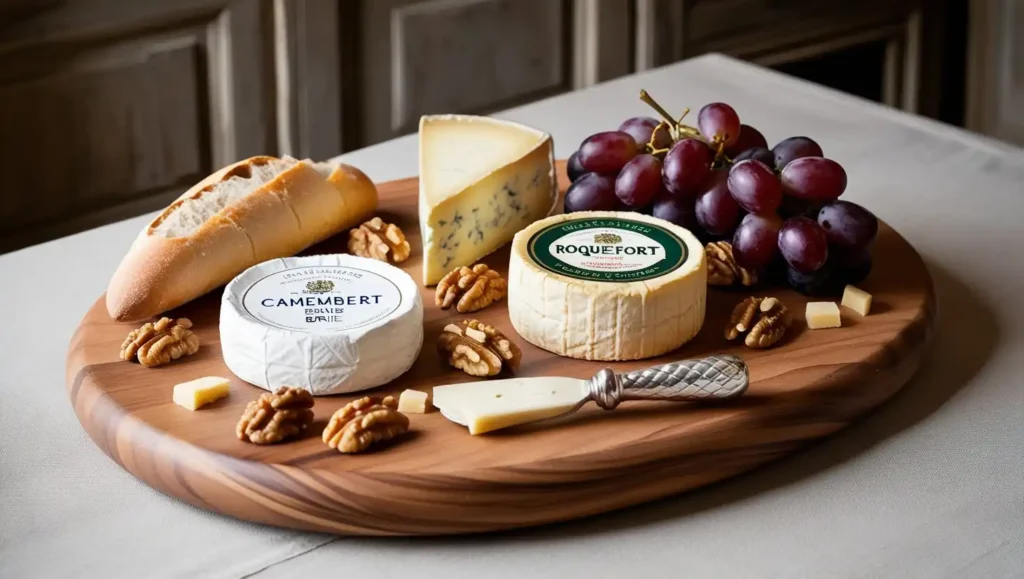
Fromage is an alternative to the outdated savoury course and may be served before or after the sweet course. It is usually served with butter, crackers, and occasionally.
Fromage bridges the gap between savoury and sweet courses, offering a flavorful and textural contrast.
All types of cheese may be offered together with appropriate accompaniments, the ideal cheese board will combine hard, semi-hard, soft or cream, blue, and fresh cheese.
Some examples of cheese are:
- Brie: Soft, creamy French cheese with a bloomy rind.
- Roquefort: Blue cheese made from sheep’s milk, known for its strong flavour.
- Camembert: Soft, creamy cheese with a characteristic earthy taste.
- Comté: Firm, aged cheese with a nutty flavour.
- Chèvre: Goat cheese with a tangy, earthy flavour.
- Gruyère: Swiss cheese with a smooth, slightly salty taste, often used in fondue.
- Saint-Nectaire: Semi-soft cheese with a creamy texture and a strong aroma.
Cover: Quarter plate or cheese plate, small knife, small fork
16. Dessert (Fruits)
Pronunciation: “day-ZAIR”
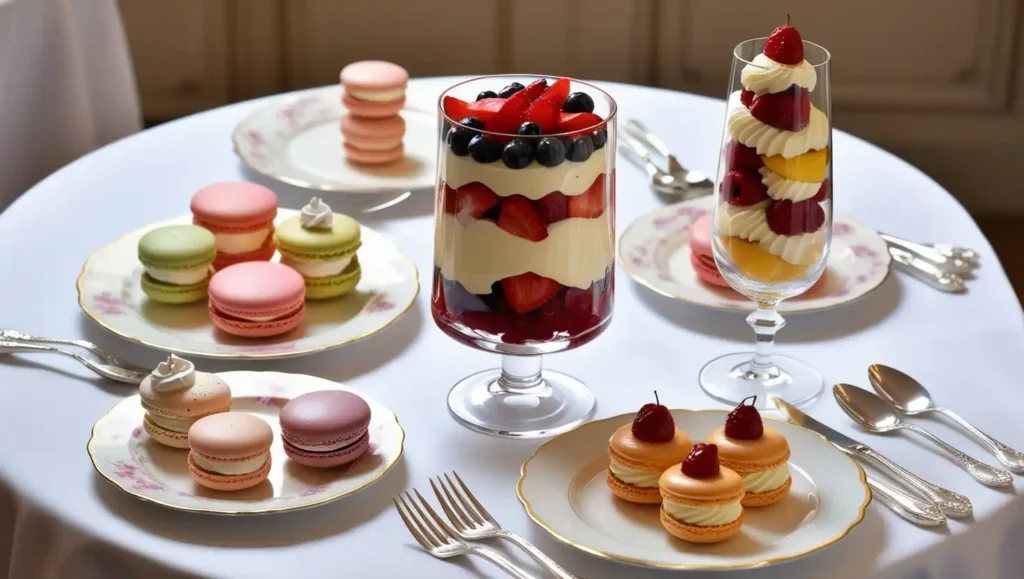
All forms of fruit and nuts may be served accompanied by castor sugar and salt.Prepared/pre-cut fruit should be considered as an example of a sweet course.
Fresh fruits that can be comfortably managed by the guests themselves at the table should be preferred on the menu.
Fruits are served in the fruit basket, and placed on the table at the time of this course. Cutlery provided as a fruit Knife and a fruit fork
Types of fruit served in the dessert course:
- Soft fruit: Banana papaya
- Hard fruit: Pears, apple
- Citrus fruit: Orange, sweet lime
- Dry fruit: Raisin, walnuts, cashouts, pistachio
Cover: Half plate, fruit fork, fruit Knife. A nutcracker is provided if nuts are served.
17. Cafe(coffee)
Pronunciation: “ka-FAY”
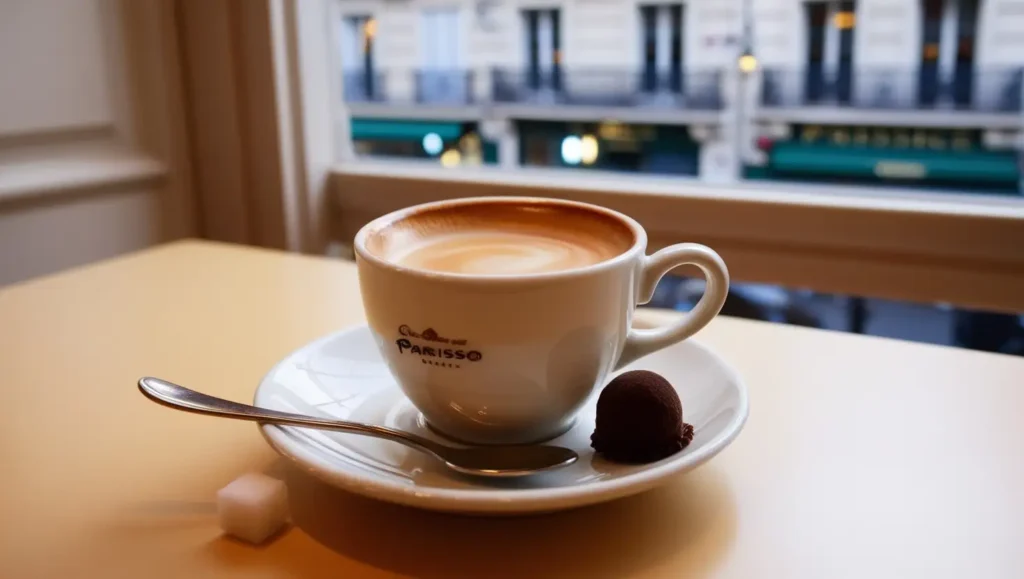
The seventeenth course, café (coffee), marks the end of the French classical menu. A variety of teas and coffees are served, with or without milk, offering a warm, comforting finish to the meal.
This course provides a final, relaxing moment to enjoy the rich and diverse flavours of the preceding dishes. Café is the perfect conclusion, allowing diners to reflect on the experience. It signifies the end of the meal and completes the traditional French dining experience.
Examples of cafe are:
- Espresso: Strong, concentrated Italian coffee.
- Cappuccino: Espresso topped with steamed milk and foam.
- Café au Lait: French coffee with equal parts brewed coffee and steamed milk.
- Café Noir: Strong black coffee, typically served without milk or sugar.
- Irish Coffee: Coffee mixed with Irish whiskey, and sugar, and topped with cream.
- Café Creme: Espresso with a dollop of cream.
- Decaf Coffee: Coffee made without caffeine, served in various styles.
Cover: Demitasse or coffee cup and saucer, coffee spoon, sugar tong, milk pot, sugar pot, coffee pot.
Summary Table of the 17 Courses
| Course | Examples | Covers |
|---|---|---|
| 1. Hors-d’oeuvre | Russian Salad, Melon | Half plate, fish fork |
| 2. Potage (Soup) | Consommé, Bisque | Soup bowl, soup spoon |
| 3. Oeufs (Egg) | Omelette, Eggs Benedict | Half plate, small fork |
| 4. Farineux (Pasta) | Risotto, Macaroni au Gratin | Half plate, fork, spoon |
| 5. Poisson (Fish) | Grilled Salmon, Sole | Fish plate, fish fork |
| 6. Entrée (Meat) | Chicken Chasseur | Half plate, joint fork |
| 7. Relevé (Main Meat) | Roast Beef, Grilled Pork | Large plate, joint knife |
| 8. Sorbet | Lemon Sorbet, Raspberry | Sorbet glass, dessert spoon |
| 9. Rôti (Roast) | Roast Chicken, Duckling | Large plate, joint fork |
| 10. Légumes (Vegetable) | Glazed Carrots, Asparagus | Half plate, fork, spoon |
| 11. Salade (Salad) | Caesar Salad, Mixed Greens | Salad plate, salad fork |
| 12. Buffet Froid | Pâté, Cold Cuts | Half plate, small fork |
| 13. Entremets (Sweet) | Soufflé, Crêpes Suzette | Half plate, dessert fork |
| 14.Savourex (savory) | Meat Savory, fish savory | Savory plate, small fork. |
| 15. Fromage (Cheese) | Brie, Gouda, Cheddar | Cheese board, small knife |
| 16. Dessert | Fresh Fruit, Nuts | Fruit fork, fruit knife |
| 17. Café (Coffee) | Espresso, Black Coffee | Coffee cup, saucer |
Download this article as a PDF for offline reading and reference. Click the link below to access the full PDF version of this guide.
RELATED ARTICLE:
- Table d’hôte menu, meaning, characteristics, advantage and disadvantage
- A la carte menu, meaning, characteristics, advantage and disadvantage
- What is Menu Planning? Definition, Importance, and Best Practices
FAQs of French classical menu
What is a 17-course French classical menu?
A 17-course French classical menu is a traditional dining sequence in French cuisine that features a variety of courses served in a specific order, starting with appetizers (Hors-d’oeuvre) and ending with coffee (Café).
What is the purpose of a 17-course menu?
The purpose of a 17-course menu is to provide a complete dining experience, showcasing a variety of flavors, textures, and culinary techniques while maintaining balance and sophistication.
What are the main courses in a French classical menu?
The main courses include Entrée (first meat course), Relevé (main meat or joints of meat), and Rôti (roast course).
Is the 17-course menu still followed today?
While the 17-course French classical menu is rarely followed in its entirety today, elements of it are still used in fine dining and formal occasions to create elaborate dining experiences.
Conclusion
The 17-course French Classical Menu represents the pinnacle of fine dining, balancing flavours, textures, and temperatures in a carefully curated sequence. Understanding this menu is essential for hospitality professionals, students, and culinary enthusiasts alike.
By mastering the art of the French classical menu, you gain insights into the elegance and precision that define French gastronomy.
Subscribe and join our community of hospitality professionals & students — get insights, tips, and the latest updates delivered straight to your inbox!

